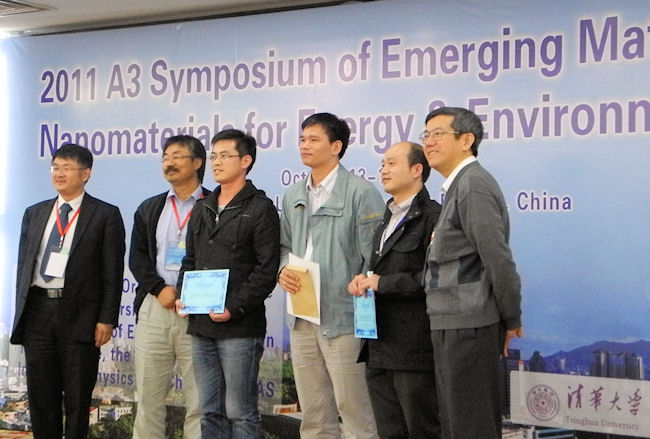独立行政法人産業技術総合研究所
 ナノシステム研究部門
ナノシステム研究部門
ナノ炭素材料研究グループのページに戻る
劉華平特別研究員がA3シンポジウムでポスター賞を受賞
ナノ炭素材料研究グループの劉華平特別研究員は、平成23年10月13−15日に中国ウルムチで開催されたThe 2011 A3 symposium of Emerging Materialsにおいて、ポスター賞を受賞しました。アブストラクトは以下の通り。
Cheap and Easy Chirality Separation of Single-wall Carbon Nanotubes by Gel Chromatography
Huaping LIU, Yasuko Urabe, Takeshi Tanaka, Hiromichi Kataura
Abstract
It is well known that the electronic types (metallic or semiconducting) and band-gaps of single-wall carbon nanotubes (SWCNTs) are determined by their chiralities (n, m). The current production methods usually generate the mixtures of SWCNTs with various chiralities. A population of single-chirality SWCNTs with well defined properties is essential for investigating the intrinsic excellent electronic properties of SWCNTs and fabricating high-performance SWCNT devices. Therefore, intense efforts have been made to develop post-growth sorting methods. Recently, we employed agarose gel chromatography method [1] to separate chiralities of SWCNTs [2]. In this method, metallic SWCNTs are firstly eluted with sodium dodecyl sulfate (SDS) solution. A low-resolution chirlaity separation of semiconducting SWCNTs can be achieved by successively adding several concentrations of sodium deoxycholate (DOC) solution.
Here, we report a highly effective multicolumn gel chromatography (MUGEC) method to separate single chirality of SWCNTs by using Sephacryl gel as the medium [3]. This method is based on the structure-dependent interaction strength of SWCNTs with the gel. In this method, several Sephacryl gel columns were collected in a series and then overloaded with SWCNT/SDS dispersion. The SWCNTs, that exhibit the strongest interaction with the gel, were selectively adsorbed on the first gel column. The unbound SWCNTs flowed through to the second column and the nanotubes with the second strongest interaction with the gel are adsorbed in this stage. Finally, nanotubes with different structures are sorted across the different columns on the basis of the strength of their interaction with the gel. In this manner, single-chirality separation has been easily performed. Metallic SWCNTs were finally collected as unbound nanotubes because they exhibit the lowest interaction with the gel. In the present method, only inexpensive commercial surfactant (SDS) and Sephacryl gel are used. Moreover, the Sephacryl gel can be reused. Therefore, MUGEC is an effective, cheap and easy method for the chirlaity separation of SWCNTs, which makes it possible that single-chirality SWCNTs are industrially applied in electronic divices.
References:
[1] T. Tanaka et al. Appl. Phys. Express 2 (2009) 125002.
[2] H. Liu et al., J. Phys. Chem. C 114 (2010) 9270.
[3] H. Liu et al. Nat. Commun. 2(2011)309
--------------------------------------------------

授賞式の様子。右から二番目が劉氏
 ナノシステム研究部門
ナノシステム研究部門